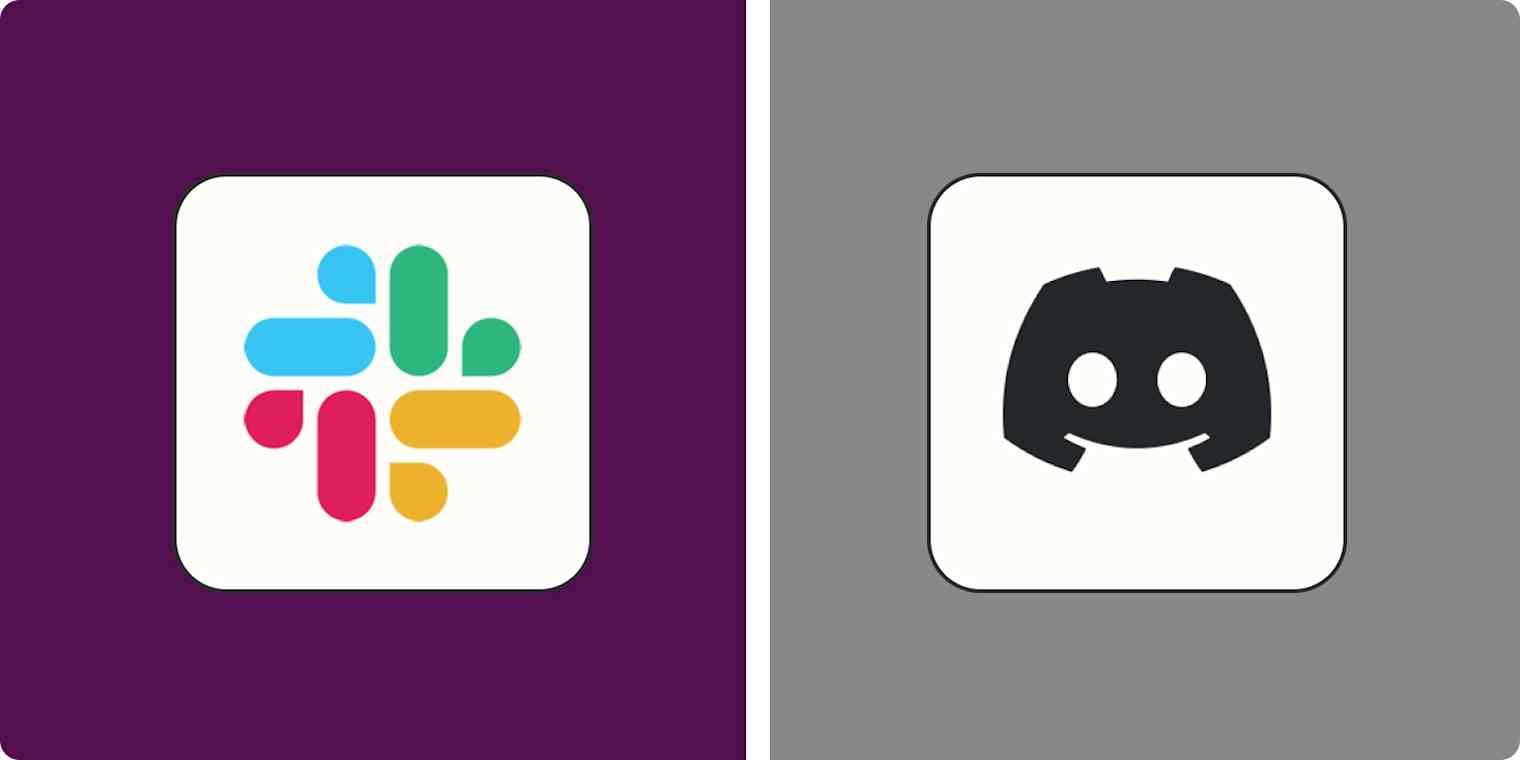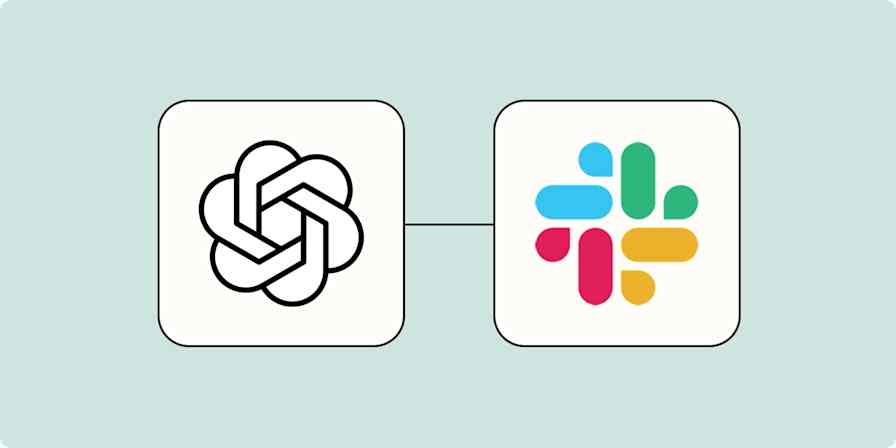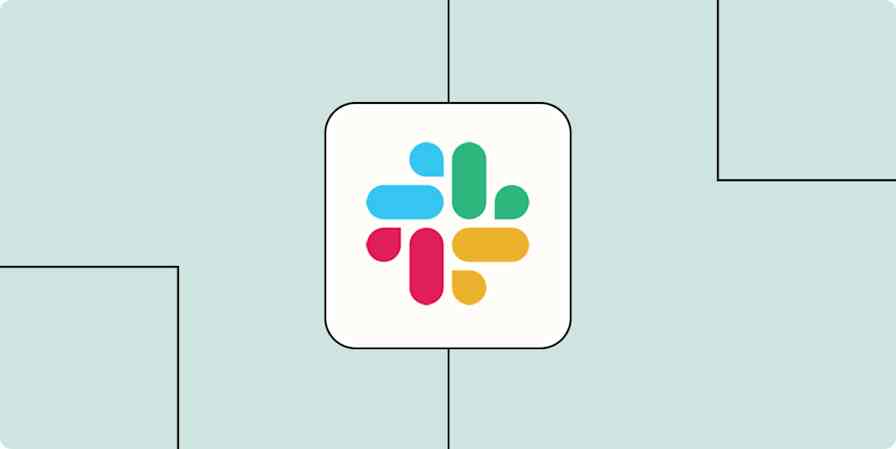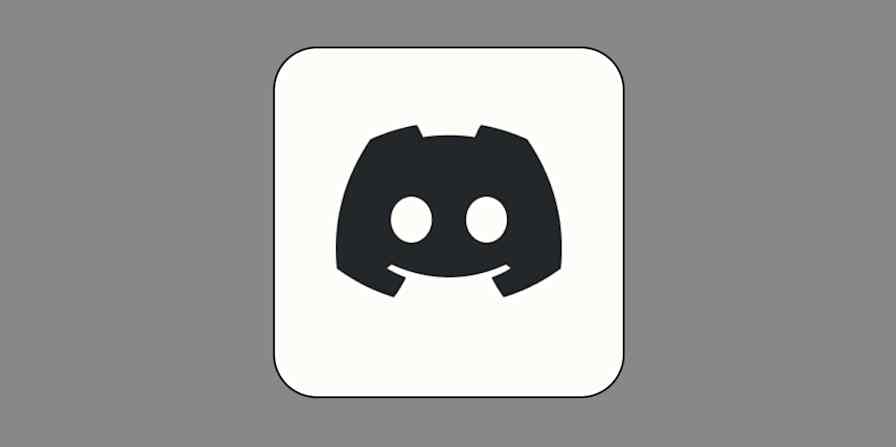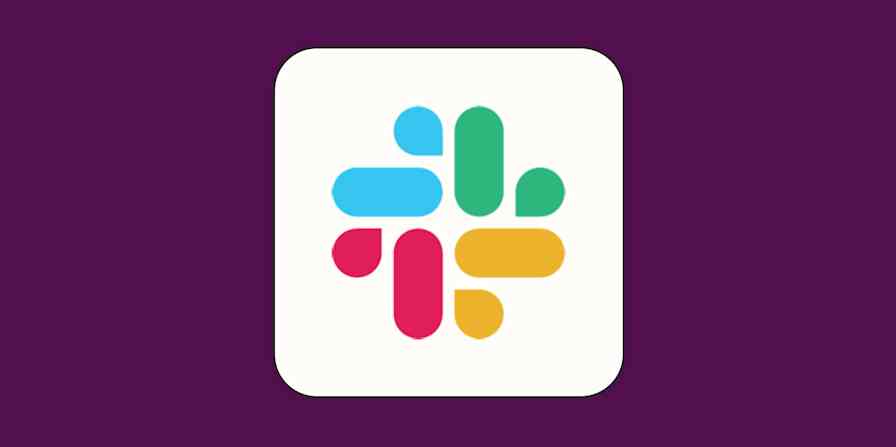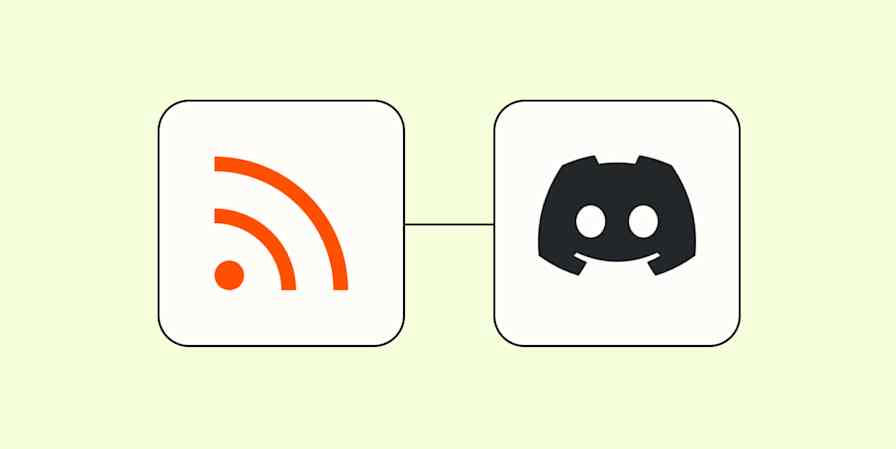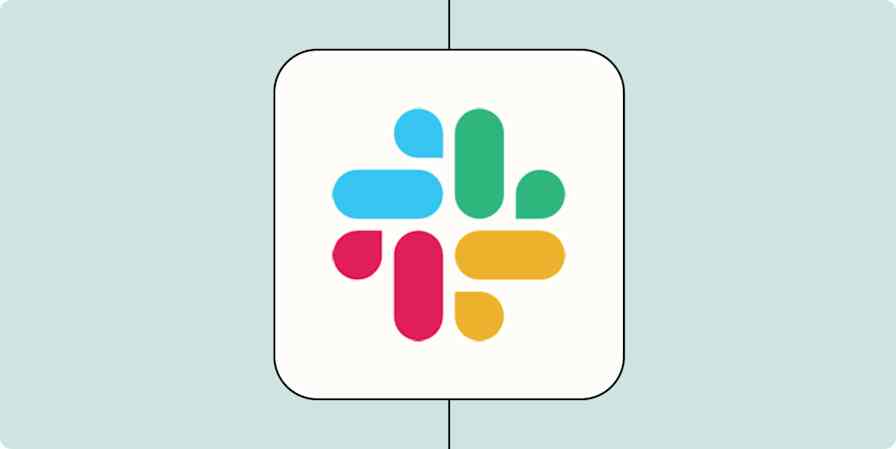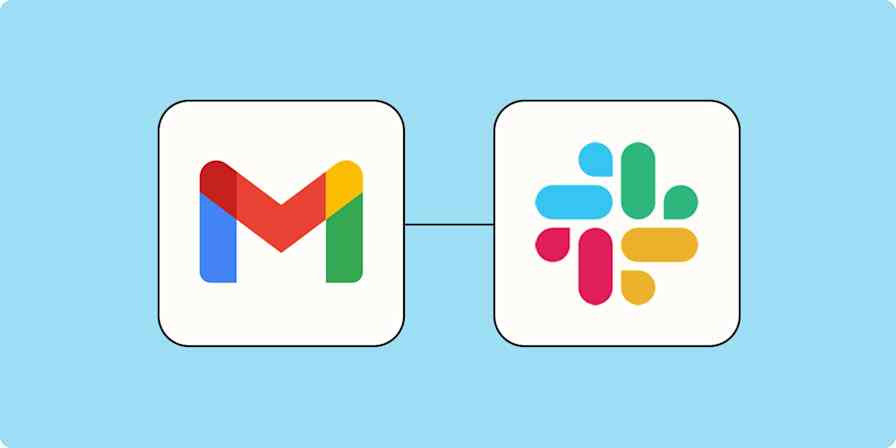Comparing Slack to Discord doesn't, at first glance, make sense. It's apples to oranges—or, more accurately, conference room to arcade—in terms of branding. I mean, look at the homepages:
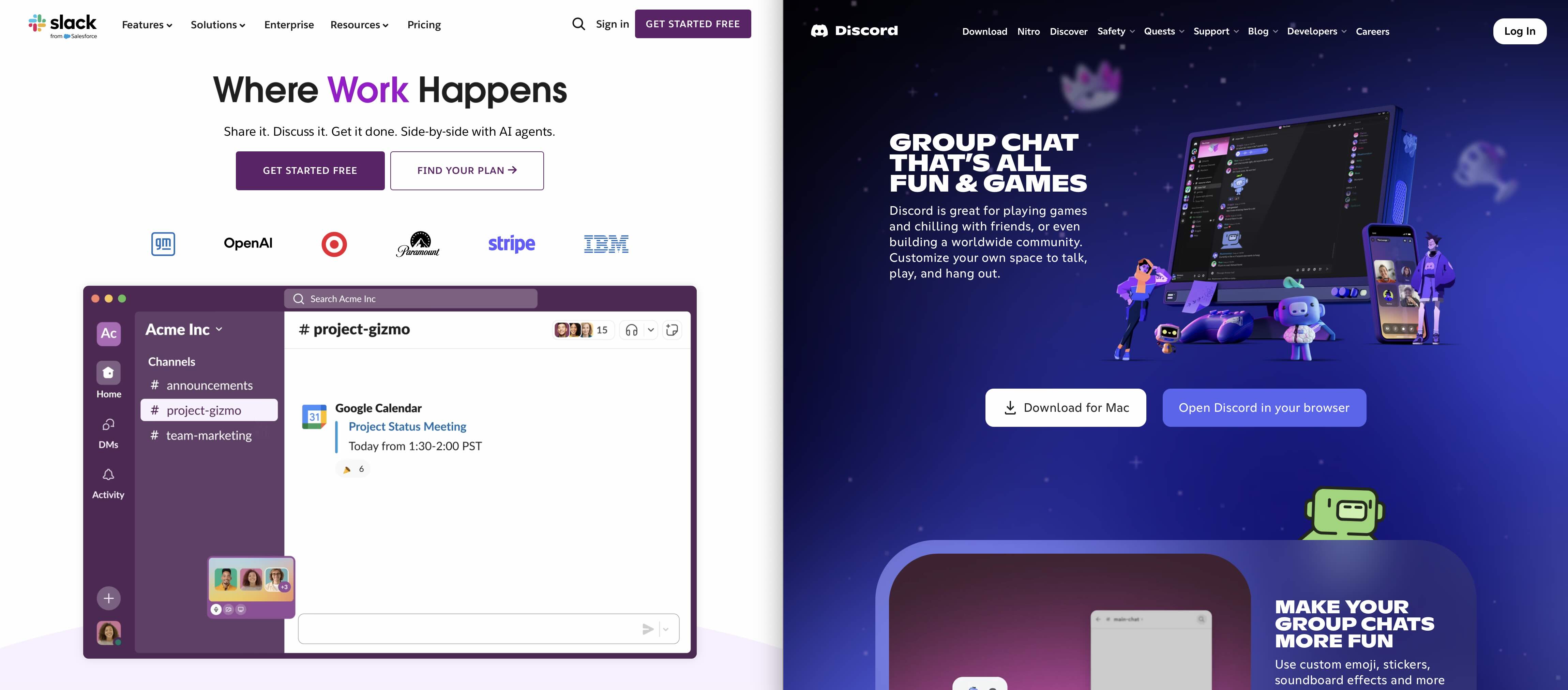
Slack is all-in on business, calling itself "Where Work Happens." Discord, historically a gaming tool, these days aims to serve online communities more generally and calls itself "Group chat that's all fun & games." The contrast couldn't be more clear—Slack is for work, Discord is for play.
Peel away the branding, though, and these two apps aren't so different. They even look similar on the inside.

Both have a left sidebar full of icons, depending on which group of people you want to talk to. Beside that is a list of channels, then the current conversation, and a right sidebar. It's uncanny.
The similarities continue. Both offer teams the chance to set up multiple channels for text conversation. Both offer video and audio calls. And both are used by millions of people every day, which is part of why they both made Zapier's list of the best team chat apps.
So, I understand why people might think these apps are interchangeable—to an extent, they are. There are plenty of online communities that happen on Slack, and some people use Discord for business. There is overlap.
But these apps aren't entirely interchangeable. They have different strengths and weaknesses, which reflect their designers' priorities. Let's break those down and talk about what makes sense to use in which contexts.
Table of contents:
Slack vs. Discord at a glance
Slack | Discord | |
|---|---|---|
Text chat | ⭐⭐⭐⭐⭐ Highly structured, with threads, Activity view, unlimited custom emoji (even on free), formatting buttons, and file uploads up to 1GB. | ⭐⭐ Added threads, but lacks Activity view, sidebar customization, and file upload is limited to 10MB on free; 50–250 emoji based on boosts. |
Audio and video communication | ⭐⭐ Offers huddles (limited on free) and calls, but less reliable, and many users rely on Zoom instead. | ⭐⭐⭐⭐⭐ Built around always-on audio channels, excellent quality, volume control, video, and screen sharing. |
App integrations | ⭐⭐⭐⭐⭐ Thousands of official business app integrations, deeply embedded into workflows. | ⭐⭐⭐⭐ Minimal official integrations, mostly community-built bots; but Zapier extends this to thousands of other apps |
Workspace control and admin tools | ⭐⭐⭐⭐⭐ Company-owned workspaces with robust admin control; DMs are contained within organizational boundaries. | ⭐⭐ Moderation-based control more akin to Reddit; DMs exist outside server boundaries and are less governed. |
Pricing and accessibility | ⭐⭐ Limited free plan (e.g., 90-day message history), and per-user monthly fees make scaling expensive for communities. | ⭐⭐⭐⭐⭐ Entirely free for core features; Nitro offers individual perks like increased file size and emoji. |
Extra features | ⭐⭐⭐⭐⭐ Offers productivity features like Canvas (wikis), Lists (project management), and deep integration with work tools. | ⭐⭐⭐⭐⭐ Prioritizes community features like onboarding flows and Forum Channels for asynchronous, persistent discussion. |
AI features | ⭐⭐⭐⭐ Advanced AI tools (in Business+ tier): conversation/file summaries, contextual search, translation. | ⭐⭐ Limited AI: experimental conversation summarization available only on select servers. |
Slack does text chat better, especially for work
Text chat seems simple enough. You type something, you press enter, then your team can see it. And that's true, but put a bunch of people in a chat room, and things get disorganized quickly. Both Slack and Discord clearly have this in mind, but Slack seems just a bit more focused on keeping things organized—particularly if you're working on a large team.
Discord has been catching up on this—adding threads was a big step. But there are still a lot of small quality-of-life things that Slack does just a little bit better.
Slack lets users privately save posts for future reference; Discord doesn't.
Slack offers an Activity view, allowing you to see conversations that mention you, threads you're in, and emoji reactions to your posts in one place; Discord offers an Inbox with mentions, but no way to monitor emoji reactions.
Slack lets you organize your sidebar using folders; Discord only allows this to happen at the server level, so individual users can't customize their own sidebars.
Slack users can upload an unlimited number of custom emoji, even on the free version; free Discord servers are limited to 50 emoji; the number can get up to 250 depending on how many users decide to pay to "boost" a given server.
And it's not just text—this extends to other features. Discord users can't upload files larger than 10MB on the free version (or 500MB if they're paid users in the highest tier). Slack limits files to 1GB, even in the free version, which is obviously a lot more generous (though free servers are limited to 5GB of free storage total).
I could go on. Slack has all kinds of little chat touches that Discord lacks. One of Zapier's most read articles is about how to bold on Discord because Discord doesn't do anything to help people learn how its formatting works. Slack has obvious formatting buttons. There's just more attention to detail on Slack when it comes to text chat.
This isn't to say that Discord is unusable. Slack just has more polish, and that gives it an edge in this category.
Discord does audio and video better
Slack offers video chat. A lot of their customers pay for Zoom. How much more do I really need to say? Audio and video calls simply aren't Slack's strengths.
Discord, however, excels on the AV front. Audio channels are what Discord built its reputation around. Gamers left the service running in the background on their computers, so they could talk to each other while playing online games. It's important for audio chats to have very little lag in that context, and Discord delivers—Slack, meanwhile, is lacking on that front. Discord's sound quality is also much better, and there are all kinds of options Slack lacks. You can adjust the volume for everyone in the conversation, for example.
As of a few years ago, there was a different philosophy here, but the two apps have more or less converged. Discord offers dedicated audio channels, which users can turn on and off whenever they want. It's less like a call and more like a room you stop by in. This is perfect for gaming and general hanging out, but it's also a great co-working tool. People can stop by and leave as they like, and there's even video and screen sharing. Slack has a feature called huddles that's very similar to Discord's always-on audio channels and can largely be used the same way, but they're not as core to the product. (Note: huddles are limited to two people in the free version of Slack, functionally making them almost useless.)
Both services also offer something more like traditional phone calls, with video and screen sharing. In my tests, Slack works a lot less reliably, which is probably why so many Zapier customers connect Slack to Zoom.
Slack has better integrations (but you can work around that)
Slack offers thousands of integrations with all kinds of business applications, from Google Drive to Zoom. Discord doesn't really offer official integrations, relying instead on bots built by third parties. These tend to be focused less on getting work done and more on building communities, which again makes sense given each app's target market. But if you rely on officially supported integrations with SaaS apps, Discord probably isn't the best fit.
There are workarounds, though. You can build a Discord bot using Zapier, for example. Or you can use Zapier to connect Discord to any of the other apps you use, allowing you to build just about any Discord integration you can imagine. You could, for example, find out when there are new posts in an RSS feed or when a new YouTube video is posted. But you could also create more work-related workflows, like alerting you when a meeting is about to start or when a new task has been added to your project management tool. Learn more about how to automate Discord with Zapier, or get started with one of these pre-made templates.
Send new YouTube videos in Discord channel messages
Slack's built-in integrations are powerful, but with Zapier, you can turn Slack into a fully orchestrated command center across your entire tech stack. Automatically post to specific channels when deal stages change in your CRM, summarize form submissions with AI, or trigger onboarding sequences when a new hire joins. You can even build your own Slackbot that responds to specific events, routes messages based on logic, or interfaces with tools like GitHub, Notion, and Google Calendar. Get ideas for automating Slack, or try one of these workflows.
Zapier is the most connected AI orchestration platform—integrating with thousands of apps from partners like Google, Salesforce, and Microsoft. Use interfaces, data tables, and logic to build secure, automated, AI-powered systems for your business-critical workflows across your organization's technology stack. Learn more.
Companies have more control over Slack
Slack is built with workplace administrators in mind. They own the workspace and enforce their own rules. The company owns the Slack, basically.
Discord is closer to a public website, like Reddit. It's built with community moderators in mind, and there are Discord-wide content policies and enforcement. Put simply, companies running a Slack are in control. Discord moderators aren't—at least, not to the same extent.
This extends to how direct messages (DMs) work. Slack DMs occur within a specific Slack instance, meaning you can only really chat with your co-workers. There are exceptions—you can add guests to your Slack instance, only giving them access to DMs and a few channels. There's also Slack Connect, which allows you to chat with people at other companies. Even if you're messaging someone outside your organization, however, those messages still live "inside" the organization's instance of Slack, which means the company that owns the Slack instance has access to those DM records, assuming your Slack account is paid.
Discord DMs don't work this way. DMs don't live inside a particular server—they're Discord-wide. You can DM your co-workers, sure, but you'll be using the same interface you'd use to DM anyone else. This means, in a business context, a company doesn't have access to DM logs by default—they would likely have to make a compelling legal argument to get that access.
This makes sense, given the difference in target market and philosophy. It's just worth keeping in mind.
Discord is basically free, while Slack's free version is limited
Pricing is another example of Discord being community-minded and Slack being focused on organizations.
Running a Discord server is free and comes with basically all features. Individual users can pay for Nitro (or the cheaper Nitro Basic) and unlock a few goodies, like more custom emoji and bigger upload sizes. Individual users can also opt to give boosts to servers, which unlocks more emoji slots and animated server icons. It's very much on community members to donate these perks, if they want to, and the differences are largely cosmetic.
Slack couldn't be more different. The free version lacks many key features. Most notably, the message archive is limited to the past 90 days—everything beyond that can't be searched for or scrolled up to. Other missing features include huddles, which are limited to two people on the free plan. There's also no way for an individual user to upgrade—the admin has to pay, and the price is per user. Pro, the cheapest tier, is $8.75 per user per month (billed monthly). That adds up quickly, especially for an online community. This kind of pricing is probably only sustainable for businesses.
Slack offers productivity tools; Discord offers tools for community
Slack, after being bought out by Salesforce in 2021, started adding productivity features beyond just conversation. For example, there's Canvas, which allows you to add a sort of wiki to the sidebar of any channel. There's Lists, which is a project management tool. A lot of organizations I've worked for ignore these features entirely, preferring to use dedicated tools for these purposes, but some organizations will no doubt enjoy having all of these things in one place.
Discord's focus is on offering tools for community building. The service offers a feature called Forum Channels, which offers a more asynchronous kind of communication. These channels are great for conversations that are meant to stick around longer and be referenced in the future. There are also dedicated onboarding features, making it easier for a new member to do things like confirm they understand the community rules and choose which channels they want to join.
And it all comes back to this: Slack is built for productivity, and Discord is built for community. The features offered reflect that.
Slack is more AI-forward
Slack offers an extensive AI feature set (though only in its pricey Business+ plan) that does things like summarize files and conversations. As with all technology involving large language models, the output may or may not be accurate, but it's certainly a way to have a rough idea of a day's worth of conversation. Other AI features include translation and a search feature that can answer questions using your past conversations for context.
Discord currently offers an experimental program that uses AI to summarize conversations, though it's currently labeled an experiment and only offered in a few servers. For now, if AI matters to you, Slack is the better fit.
Slack or Discord: Which should you use?
Given these differences, which service should you use? Honestly, I think you should trust the branding (and this is coming from someone who does not, as a rule, trust branding). Discord is ideal for online communities, while Slack is better for businesses. It's just what they're built for.
This isn't to say you can't mix it up. You can absolutely host an online community on Slack, particularly if you're fine with only having an archive of the past 90 days. And you can use Discord for business, if you're willing to work around some of the limitations. These tools aren't interchangeable, exactly, but they have enough similarities that you have a choice to make. Just keep the differences in mind.
Related reading:
This article was originally published in June 2019 by Dane O'Leary. The most recent update was in August 2025.
